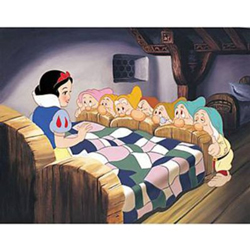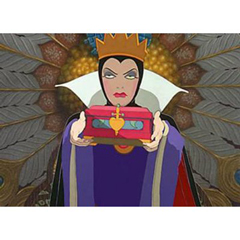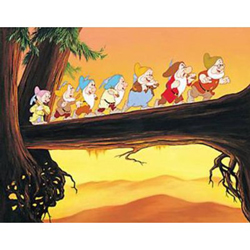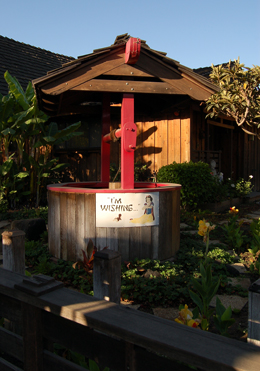
 |
|
|
|
Snow White and the Seven Dwarfs tends to melt the most cynical of critics into puddles of sentiment. The Snow White character is the most vivid representation ever of a traditional storybook heroine -- delicate, innocent and incapable of a dark thought. When she sings over the wishing well in her hopeful, trembling voice she connects with the dreams of children and the hopes of parents. The abstraction of the animated image conveys her yearning more directly than would live action. Because the figures on screen aren't live actors with whom we must decide to identify, the emotionalism in Snow White functions like a mirror. Anyone capable of a sentimental thought will spend a goodly portion of Snow White with mist in their eyes. 
If the movie looks this good now, imagine what a visual wonder it must have been in 1937, when full Technicolor was in its infancy. Walt Disney organized his army of artists to the task of creating a feature-length animated show the likes of which had never been seen. Disney makes expert use of the longer format, concentrating on character animation rather than "detailing a world" with visual and narrative complexities. The Evil Queen is alone in her throne room except for a raven, a talking mirror and the huntsman who will be asked to take Snow White on a fateful trip to the forest. The Prince is practically an accessory, as he appears the bare minimum of times needed by the story. The forest animals are fun but nothing very new for fans of Disney's color cartoons. The writers and animators prefer instead to flesh out the characters of Snow White, the Queen in her disguise as the Witch, and the "little men" in the forest cabin. A fully developed animated personality had never been seen before. Disney's skilled artists dazzle us by using action to distinguish the seven distinct characters. By the time the dwarves and Snow White are singing and dancing by the firelight the screen has almost a 3D quality. It's no longer a kiddie cartoon, as we're completely absorbed by the merrymaking on screen. The imagery also exudes an interesting sexuality that goes beyond the innocent Snow White charming her seven chaste suitors. The dwarves are cartoon-based caricatures organized around basic shapes and exaggerated physiognomy. Ms White is roto-scoped (from the delicate mime of Marge Champion) as a stylized but naturalistic human figure, and appears to be of entirely different species than her new friends. The dwarves are content with having a new mother-sister figure to adore; romantic ideas beyond kisses on the forehead are sublimated into wistful daydreams and desires. As for the Prince, he seems almost 2D compared to the fully-fleshed Snow White and remains as abstract as a cut-out doll. Although the Prince raises Snow White from the dead, the final image shows not a wedding but a castle in the clouds. A literal interpretation of this might be that Snow White receives her amorous reward only in heaven. Disney's fairy tale idealism presents wholesome human emotion as far too beautiful to be confused with anything so physical as sex. When this vision works as well as it does in Snow White, we're almost ready to sign on. 1 
The jeopardy aspect of Snow White was certainly debated in 1937; we're told that in parts of England the movie was considered too intense for children. That of course depends on the kids. The spooky expressionist imagery in the "lost in the forest" scenes outdo some of the silent German masterpieces. Children never forget the film's ghostly phantoms, trees with branches that cling like claws. The fast cutting in this scene impressed Sergei Eisenstein, while a generation of Italian horror filmmakers cited Snow White as a prime influence on their work. Disney doesn't give us a close-up of a bleeding pig's heart but he plays the fate of the evil Witch like something from Wagner. The fairy tale's rough edges are still there -- those loveable dwarves become a rather vindictive death squad. It's not difficult to find criticism that characterizes early Disney Fairy Tales as unhealthy, conservative and an obstruction to the progress of approved roles for women in the social order. This seems a ridiculous burden to place on Disney's show. I prefer to see Snow White as what it is, an expression of American values in 1937, good, bad and indifferent. Snow White's business is to remain pure, sweet and helpful to those around her. She's rather helpless and vulnerable, but her innocence inspires all of nature's creatures to come to her aid. Without being asked, she becomes mother and babysitter to a pack of infantile child-men. Having experience as a servant as well as a princess, Snow White instantly pledges herself as a homemaker (how American can a princess get?). She is helpless against the wicked and the clever. It remains for heaven, earth and magic to right wrongs and let Snow White live happily ever after. This is a fantasy of ideals woven into the social fabric of an earlier era. By all means examine the Disney viewpoint for what it is, but don't knock the art. Disney DVD's Diamond Edition Blu-ray of Snow White and the Seven Dwarfs is an all-round deluxe product, and the film transfer itself is a knockout. The flaws noted in earlier video editions -- softness, indistinct colors -- are all but eliminated, leaving a clean and bright image that more clearly resembles the surviving animation cels themselves. No detail seems to have been erased, and character shadings have not changed. Blu-ray is brighter than NTSC video so some viewers might think the images have been artificially enhanced. I'm not fit to judge if whites that were once tinted in various 'time of day' tones have been neutralized to BD-friendly flat white. But certainly no conceptual re-paint job has taken place, as seems to be the case with a previous DVD of Peter Pan. Again, a comparison with original cels makes it look as if the entire film had been scanned and re-composited from pre-film artwork. 
Original animation anomalies remain, appropriately so. I noticed some mottled deerskin, and a cart at the mine that pops on and off rather awkwardly. In one shot the dwarves exiting the mine simply pop on, an animation event that was always there. I see no evidence of animation inconsistencies from 1937 being revised. The show is viewable in a format called "Disney View", which adds discreet artwork borders to the sides of the 1:37 image, to fill widescreen HD monitors. I'll not be using this feature, but it may be an attractive option for viewers concerned about old-fashioned image burn-in problems. The Combo Pack Diamond Edition game plan already used on the release of Pinocchio puts the feature and a few extras on one Blu-ray disc, with a second HD disc carrying extras. A third DVD disc carries a standard-def encoding of the same restoration. This makes good sense for viewers aware of Blu-ray but not yet willing to commit to the format; one can see the movie at home and perhaps take the superior disc along on a visit to friend with Blu-ray. Or conversely, a family can watch the Blu-ray and still be able to see the show in portable devices, on trips, etc. It's a nice move that builds interest in the Blu-ray format: I remember buying a few laserdiscs a year before I could afford a player of my own. The DVD disc carries a commentary by John Canemaker. It's a historical / practical overview packed with information and expert opinion. The BD feature disc includes a piece about an unfilmed "Snow White Returns" short subject, two deleted scenes in pencil test form, a music video and four games. The Bonus disc has a pleasing new HD featurette, The One that Started It All and a cleverly formatted tour of the production process at the Hyperion Studios. The camera appears to drift into and through vintage stills, pausing occasionally when a spokesman -- who at first seems to be part of an original still -- suddenly comes to life. The bonus disc also contains an older piece about the voice talent used for the film and a lengthy compilation called Disney Through the Decades. Various celebrity spokespeople chart the history of the studio, a progression from the Walt years to today's corporate empire. These chapters are interrupted by Snow White trailers for successive theatrical releases spanning sixty years. The bonus extras finish off with a Karaoke sing-along piece and another game. 
The menu system's Magic Mirror character prompts the viewer and occasionally encourages us to program the extras in a personal order called "Smart Navigation". Savant prefers using the paper insert that lays out the extras in a graphic tree; I still appreciate Warners' simple inclusion of a menu screen that displays all the choices at once. The insert lists Dumbo, Beauty and the Beast and Fantasia & Fantasia 2000 as coming next in the Diamond Edition line. A Tiffany Thornton music video and promos for new Disney product proliferate and one must click through a series of ads to get to the feature itself. My suggestion is to load the disc a few minutes before you actually want to watch Snow White, so as to be able to directly start up the feature when everyone sits down. Also in the keep case is a promotional pamphlet and other tie-in material. The cover art image of Snow White has been modernized from the round-cheeked & demure 1937 original to a sleeker post-millennial princess-chick. This more self-aware new version looks at the camera with an expression that says, "I'm pretty". She now fits right in among the other interchangeable Empowered Princesses. The latest Disney role model from The Princess and the Frog is an outspoken beauty with 'tude. With her forceful personality, she'd probably go all kung fu on the ugly witch and her poison apple. 2
On a scale of Excellent, Good, Fair, and Poor, Footnotes:
1. Curiously, Howard Hawks' 1941 Ball of Fire addresses (and resolves) this clash between the Ideal and the Sexual. Billy Wilder and Charles Brackett's screenplay is a direct takeoff on Snow White, substituting Barbara Stanwyck's gangster's moll and club singer Sugarpuss O'Shea for Snow White. Seven cute college professors stand in for the
3. About three blocks from my home in Larchmont is the house that Adriana Caselotti lived in. It has a little wishing well in the front yard. When we had small kids in the 1980s, neighbors told us to walk them by the house some time. We were all dressed up one Easter and decided to take a stroll down that way. Ms. Caselotti did what we were told she might do, she stepped out of her front door and sang a few bars of "I'm Wishing". The voice was the same one in the movie, even if fifty years later. She didn't talk to us, really, but apparently enjoyed singing to children. A very sweet memory. (Image of the wishing well as it is now, pictured above ... the little sign says, "I'm Wishing".)
Reviews on the Savant main site have additional credits information and are often updated and annotated with reader input and graphics. Also, don't forget the 2009 Savant Wish List. T'was Ever Thus.
Review Staff | About DVD Talk | Newsletter Subscribe | Join DVD Talk Forum |
| ||||||||||||||||||